Build Your LinkedIn Profile Presence With LinkedIn Content Strategy
If you want to fully utilise the amazing power of LinkedIn, you need to publish content.
Why?
This article answers that question. It also explains:
- Why we should publish content on LinkedIn.
- What formats are available.
- How they work.
- The best types of content to post.
- And how you get those posts seen by more people.
Why is publishing content so critical to LinkedIn success? Here are 10 reasons:
- Gives you visibility
- Establishes credibility
- Allows you to develop relationships with potential customers
- Makes your company look good
- Enhances your personal brand
- Helps widen your network
- Elevates your reputation as a thought leader, industry expert or influencer
- Shows you know what’s going on in your industry
- Helps you be found on LinkedIn and online
- Sends people to your profile who may want to work with or hire you
In a nutshell, you want to be visible online. You want to showcase your expertise and indicate why and how you are an expert in your field. And you want to enhance your credibility so people will learn to trust you. They will know that you are a person who gives good-value information. You’re not just out for number one and you really want to help them in their business. That makes you a trustworthy person. And don’t we all want to do business with people we know, like and trust?
Post formats
There are seven formats available on LinkedIn:
- 🎡 Text
- 🎡 Document
- 🎡 Image
- 🎡 Video
- 🎡 Polls
- 🎡 Articles
- 🎡 Stores
- 🎡 Preformatted
This table gives you the most important information you need to know about each one. 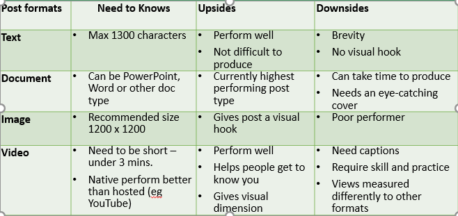
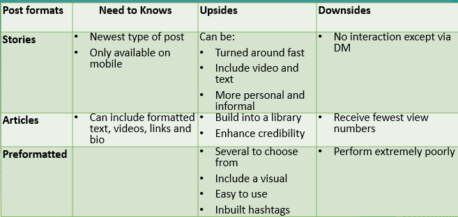
Text posts
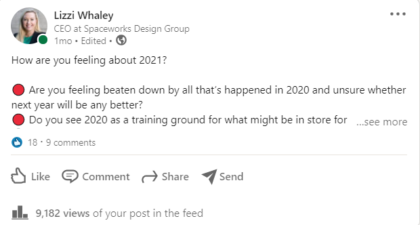 Text posts perform well in terms of views and don’t take long to produce. You can only write about 200 words however, which is the major drawback to them. Despite their being text-only, it is possible to make them visual. I like to use emojis especially with lists because one line of text is easier to read than a big block of dense text. Add three to nine hashtags. Use some that have millions of followers and some that are specific to you so you can build up a community of followers.
Text posts perform well in terms of views and don’t take long to produce. You can only write about 200 words however, which is the major drawback to them. Despite their being text-only, it is possible to make them visual. I like to use emojis especially with lists because one line of text is easier to read than a big block of dense text. Add three to nine hashtags. Use some that have millions of followers and some that are specific to you so you can build up a community of followers.
Document posts
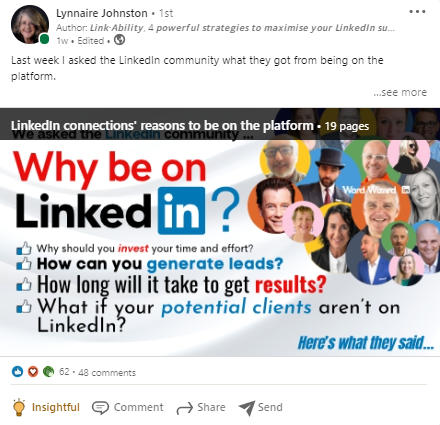 Document posts currently rank very well and can be used to showcase material in PowerPoint, Word or another type of document. Research by the Dutch social selling expert Richard van der Blom shows that document posts are the highest performing post types on LinkedIn. Your document can be a portfolio of work, it could be a checklist, or it could be a presentation that you’ve given. You need an eye-catching cover and lots of easy-to-read text inside so that people who read it on a small screen are also able to view it. I like to use my document posts in PowerPoint presentation slide size so they are slightly wider than they are high, but A4 is also widely used. These certainly grab attention in the newsfeed.
Document posts currently rank very well and can be used to showcase material in PowerPoint, Word or another type of document. Research by the Dutch social selling expert Richard van der Blom shows that document posts are the highest performing post types on LinkedIn. Your document can be a portfolio of work, it could be a checklist, or it could be a presentation that you’ve given. You need an eye-catching cover and lots of easy-to-read text inside so that people who read it on a small screen are also able to view it. I like to use my document posts in PowerPoint presentation slide size so they are slightly wider than they are high, but A4 is also widely used. These certainly grab attention in the newsfeed.
Image posts
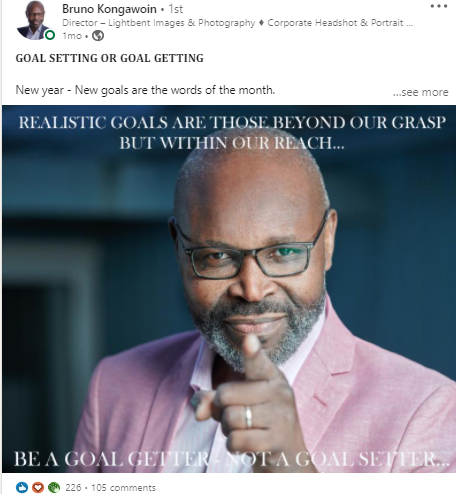 Image posts are a good way to present information because you can place text over the top of an image. When doing this, make sure it’s large and clear enough for reading on small devices. LinkedIn recommends that image posts be 1200 by 1200. But you’ll see many in your feed that are different dimensions.
Image posts are a good way to present information because you can place text over the top of an image. When doing this, make sure it’s large and clear enough for reading on small devices. LinkedIn recommends that image posts be 1200 by 1200. But you’ll see many in your feed that are different dimensions.
Video posts
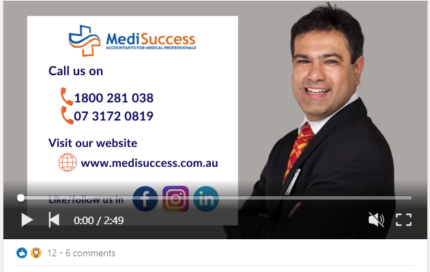 Video is a great post format for those who don’t like writing or aren’t comfortable with it. They work especially well if they are a native video (not hosted on YouTube or Vimeo) that you upload directly from your computer. However, they do need to be short – 30 to 60 seconds for preference. And they do need to have captions because not everyone will be watching this on a laptop or big screen, or where they can have the sound on. Also, use a mic and keep background noise to a minimum. It’s always a good idea to have an introduction or synopsis of your video in the text that accompanies it. This encourages people to watch the video because they know a little about the topic you’re going to share with them.
Video is a great post format for those who don’t like writing or aren’t comfortable with it. They work especially well if they are a native video (not hosted on YouTube or Vimeo) that you upload directly from your computer. However, they do need to be short – 30 to 60 seconds for preference. And they do need to have captions because not everyone will be watching this on a laptop or big screen, or where they can have the sound on. Also, use a mic and keep background noise to a minimum. It’s always a good idea to have an introduction or synopsis of your video in the text that accompanies it. This encourages people to watch the video because they know a little about the topic you’re going to share with them.
Polls
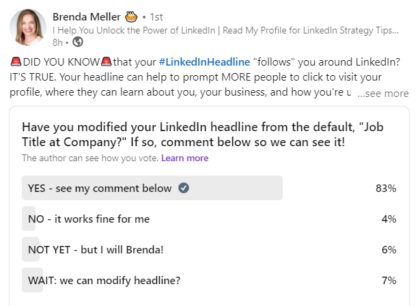 Polls, which arrived last year, are a great way to post content quickly and easily. It’s preferable to have a genuine reason to ask questions of your audience. If you write a good question, have sensible answers and get some good responses, you can create another post to talk about the responses. There are tight character limits for polls, though. Questions are limited to a maximum 140 characters and options (the list of answers) are limited to a maximum of 30 characters each. There isn’t a lot to play with, but the brevity of polls means people will be more likely to read them and respond. It’s important to solicit engagement with a poll, so ask a question that requires people to add more information in the comments below. Why? Because poll view numbers aren’t based on the number of people who vote, but on the number who view the poll.
Polls, which arrived last year, are a great way to post content quickly and easily. It’s preferable to have a genuine reason to ask questions of your audience. If you write a good question, have sensible answers and get some good responses, you can create another post to talk about the responses. There are tight character limits for polls, though. Questions are limited to a maximum 140 characters and options (the list of answers) are limited to a maximum of 30 characters each. There isn’t a lot to play with, but the brevity of polls means people will be more likely to read them and respond. It’s important to solicit engagement with a poll, so ask a question that requires people to add more information in the comments below. Why? Because poll view numbers aren’t based on the number of people who vote, but on the number who view the poll.
Stories
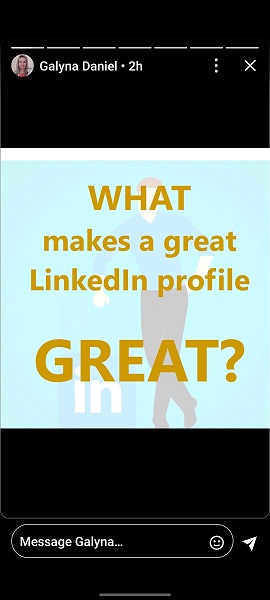 Stories are the most recent arrival to LinkedIn but so far are only available on mobiles. They can be turned around quite fast, but tend to be informal and less about business, which is unusual for a platform like LinkedIn, so it remains to be seen how useful they will be. However, frequently posting stories is a great way to showcase you and your business behind the scenes. Those with Instagram will be familiar with using stories. One difficulty with stories, however, is that the only way you can see any metrics about their success is when somebody messages you. If they do, you can tell they’ve seen your story.
Stories are the most recent arrival to LinkedIn but so far are only available on mobiles. They can be turned around quite fast, but tend to be informal and less about business, which is unusual for a platform like LinkedIn, so it remains to be seen how useful they will be. However, frequently posting stories is a great way to showcase you and your business behind the scenes. Those with Instagram will be familiar with using stories. One difficulty with stories, however, is that the only way you can see any metrics about their success is when somebody messages you. If they do, you can tell they’ve seen your story.
Articles
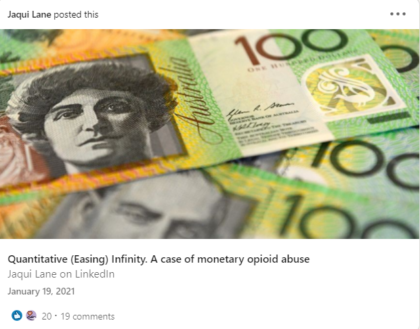 Articles build up into a body of credible work. I know people who do articles every month, sometimes every week. That’s a big ask even for professional writers because an article is a lot longer than a post, but you have more options. For instance, you can include video links to other sites and put a bio and photo of yourself at the end. While articles are an excellent way to build credibility, they don’t perform well in terms of view numbers, but you can feature them on your profile. For this reason, they are an excellent addition to the stable of formats. They also demonstrate your knowledge. Using a well-organised structure like problem solution or past, present and future is an effective way to get your message across because people can easily follow what you’re saying. Make sure you check for grammatical errors and spelling mistakes and that your material is accurate. Otherwise, your article will seem unprofessional. Hot tip: You can write articles in sections with headlines or subheadings all the way through. You can then take sections or sub-sections out of the article and repost them as text or video posts, or do something else with them. Repurposing content makes sense. It takes time and effort to come up with it in the first place, so make the most of it. Remember: articles are for credibility, not for visibility, so you probably won’t get as many responses on them as you will on posts.
Articles build up into a body of credible work. I know people who do articles every month, sometimes every week. That’s a big ask even for professional writers because an article is a lot longer than a post, but you have more options. For instance, you can include video links to other sites and put a bio and photo of yourself at the end. While articles are an excellent way to build credibility, they don’t perform well in terms of view numbers, but you can feature them on your profile. For this reason, they are an excellent addition to the stable of formats. They also demonstrate your knowledge. Using a well-organised structure like problem solution or past, present and future is an effective way to get your message across because people can easily follow what you’re saying. Make sure you check for grammatical errors and spelling mistakes and that your material is accurate. Otherwise, your article will seem unprofessional. Hot tip: You can write articles in sections with headlines or subheadings all the way through. You can then take sections or sub-sections out of the article and repost them as text or video posts, or do something else with them. Repurposing content makes sense. It takes time and effort to come up with it in the first place, so make the most of it. Remember: articles are for credibility, not for visibility, so you probably won’t get as many responses on them as you will on posts.
Preformatted posts
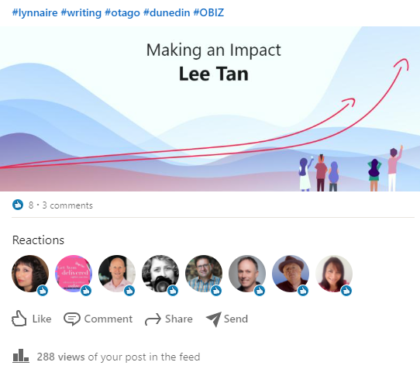 The final format is a preformatted post. These are a series of different formats LinkedIn has provided, such as welcoming a new team member, completing a project or celebrating an occasion. They come with some hashtag ideas, a bit of text and a choice of images, all of which you can change, but you don’t have to use any of them. You can take the image off and put your own on if you wish. Although LinkedIn has designed these posts, they don’t perform well. However, they are easy to use. To increase the view numbers, you can tag the people involved in your post and seek engagement on it.
The final format is a preformatted post. These are a series of different formats LinkedIn has provided, such as welcoming a new team member, completing a project or celebrating an occasion. They come with some hashtag ideas, a bit of text and a choice of images, all of which you can change, but you don’t have to use any of them. You can take the image off and put your own on if you wish. Although LinkedIn has designed these posts, they don’t perform well. However, they are easy to use. To increase the view numbers, you can tag the people involved in your post and seek engagement on it.
How to get posts noticed
It’s key to seek early engagement, which means encouraging people to comment on your posts as soon as possible after they go up.
How?
- Send your posts to people you know will respond to and comment on them, and for whom you can reciprocate
- Ask questions
- Respond to the comments yourself
If you provide high-quality and useful content, and don’t promote yourself all the time, people will want to engage on your posts. Lastly, widen your network. That means making sure you have a network of people who are involved in what you do and who will respond to your posts.
You can read more about widening your audience on LinkedIn in my new book, Link•Ability, 4 Powerful Strategies to Maximise Your LinkedIn Success, which has a section about connecting to people and ensuring you’re connecting to the right people. You can also find out much more about the posting techniques discussed in this article. To find out more visit https://www.wordwizard.co.nz/book/ or any online bookstore.
Lynnaire Johnston is the author of Link∙Ability, 4 powerful strategies to maximise your LinkedIn success and is an internationally recognised LinkedIn expert. She works with individuals and companies to help them achieve their business and professional goals. Lynnaire shares her knowledge on LinkedIn, YouTube, and here on her website.
